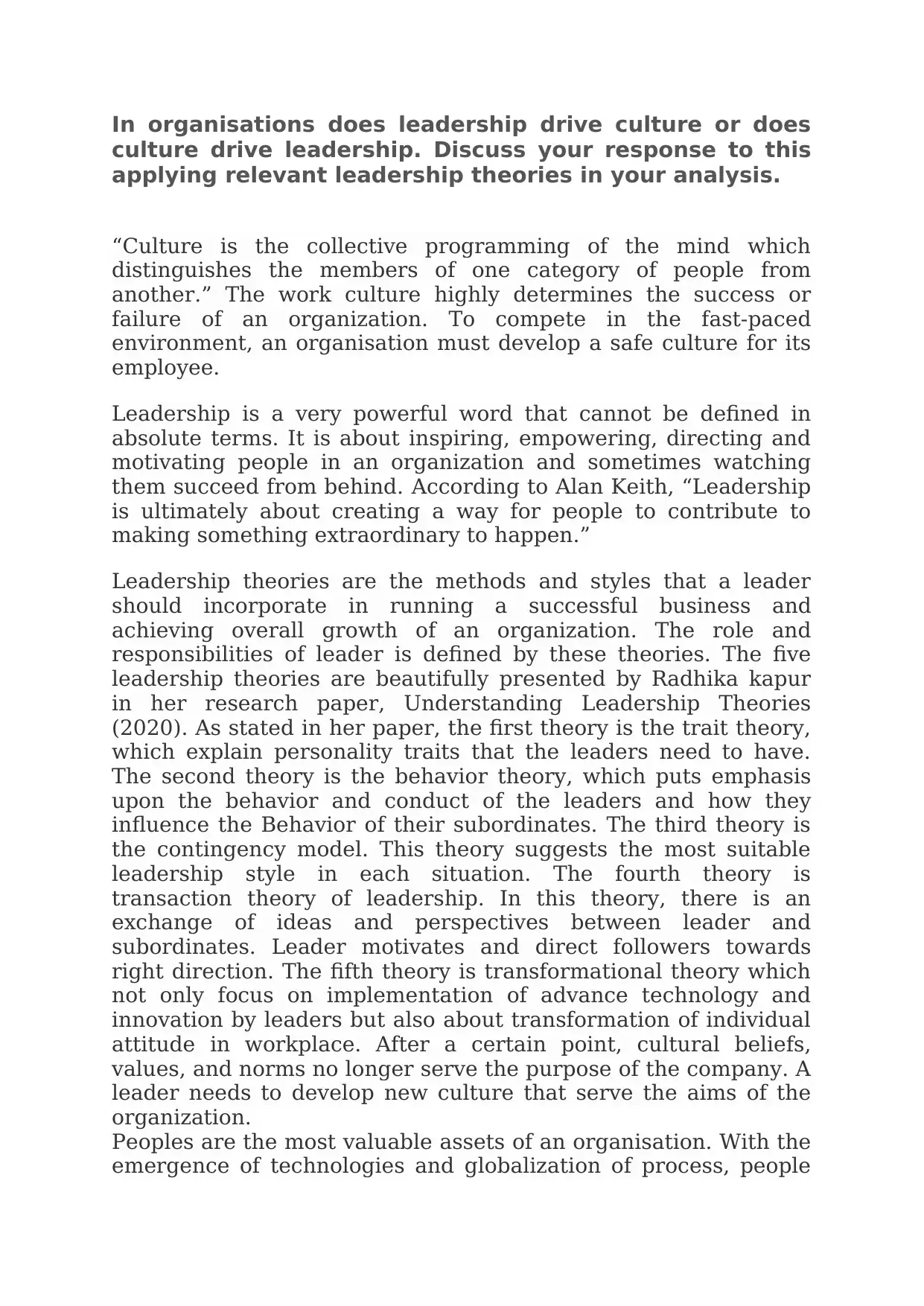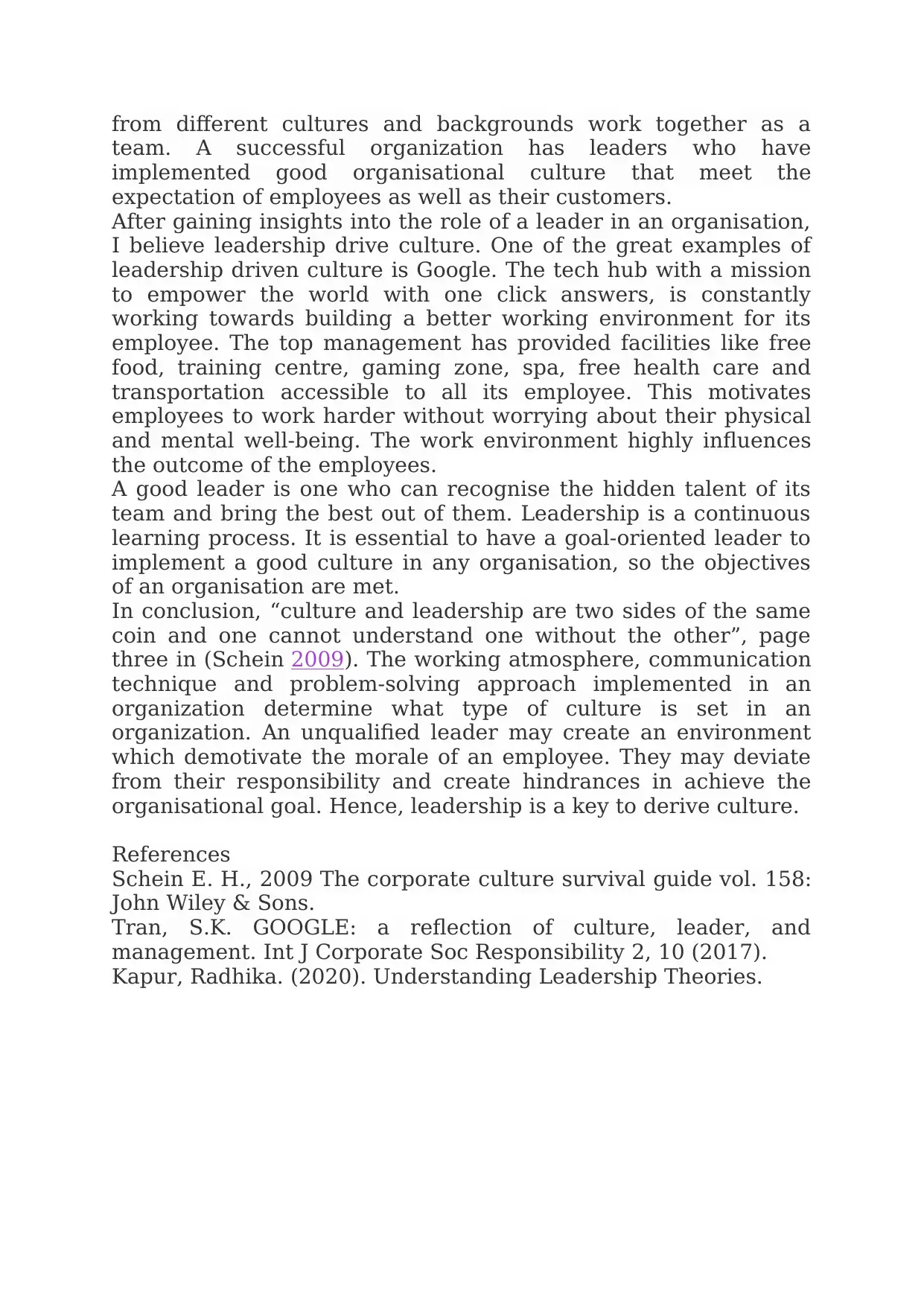Leadership's Impact on Culture: An Analysis Using Leadership Theories
VerifiedAdded on 2023/05/15
|2
|752
|401
Essay
AI Summary
This essay explores the intricate relationship between leadership and organizational culture, arguing that leadership primarily drives culture. It delves into various leadership theories, including trait theory, behavior theory, contingency model, transaction theory, and transformational theory, to analyze how leaders shape the cultural beliefs, values, and norms within an organization. The essay uses Google as an example of a company where leadership has fostered a positive and supportive culture, enhancing employee motivation and productivity. It concludes that effective leadership is essential for creating a conducive work environment and achieving organizational goals, emphasizing that culture and leadership are intertwined and mutually dependent.

In organisations does leadership drive culture or does
culture drive leadership. Discuss your response to this
applying relevant leadership theories in your analysis.
“Culture is the collective programming of the mind which
distinguishes the members of one category of people from
another.” The work culture highly determines the success or
failure of an organization. To compete in the fast-paced
environment, an organisation must develop a safe culture for its
employee.
Leadership is a very powerful word that cannot be defined in
absolute terms. It is about inspiring, empowering, directing and
motivating people in an organization and sometimes watching
them succeed from behind. According to Alan Keith, “Leadership
is ultimately about creating a way for people to contribute to
making something extraordinary to happen.”
Leadership theories are the methods and styles that a leader
should incorporate in running a successful business and
achieving overall growth of an organization. The role and
responsibilities of leader is defined by these theories. The five
leadership theories are beautifully presented by Radhika kapur
in her research paper, Understanding Leadership Theories
(2020). As stated in her paper, the first theory is the trait theory,
which explain personality traits that the leaders need to have.
The second theory is the behavior theory, which puts emphasis
upon the behavior and conduct of the leaders and how they
influence the Behavior of their subordinates. The third theory is
the contingency model. This theory suggests the most suitable
leadership style in each situation. The fourth theory is
transaction theory of leadership. In this theory, there is an
exchange of ideas and perspectives between leader and
subordinates. Leader motivates and direct followers towards
right direction. The fifth theory is transformational theory which
not only focus on implementation of advance technology and
innovation by leaders but also about transformation of individual
attitude in workplace. After a certain point, cultural beliefs,
values, and norms no longer serve the purpose of the company. A
leader needs to develop new culture that serve the aims of the
organization.
Peoples are the most valuable assets of an organisation. With the
emergence of technologies and globalization of process, people
culture drive leadership. Discuss your response to this
applying relevant leadership theories in your analysis.
“Culture is the collective programming of the mind which
distinguishes the members of one category of people from
another.” The work culture highly determines the success or
failure of an organization. To compete in the fast-paced
environment, an organisation must develop a safe culture for its
employee.
Leadership is a very powerful word that cannot be defined in
absolute terms. It is about inspiring, empowering, directing and
motivating people in an organization and sometimes watching
them succeed from behind. According to Alan Keith, “Leadership
is ultimately about creating a way for people to contribute to
making something extraordinary to happen.”
Leadership theories are the methods and styles that a leader
should incorporate in running a successful business and
achieving overall growth of an organization. The role and
responsibilities of leader is defined by these theories. The five
leadership theories are beautifully presented by Radhika kapur
in her research paper, Understanding Leadership Theories
(2020). As stated in her paper, the first theory is the trait theory,
which explain personality traits that the leaders need to have.
The second theory is the behavior theory, which puts emphasis
upon the behavior and conduct of the leaders and how they
influence the Behavior of their subordinates. The third theory is
the contingency model. This theory suggests the most suitable
leadership style in each situation. The fourth theory is
transaction theory of leadership. In this theory, there is an
exchange of ideas and perspectives between leader and
subordinates. Leader motivates and direct followers towards
right direction. The fifth theory is transformational theory which
not only focus on implementation of advance technology and
innovation by leaders but also about transformation of individual
attitude in workplace. After a certain point, cultural beliefs,
values, and norms no longer serve the purpose of the company. A
leader needs to develop new culture that serve the aims of the
organization.
Peoples are the most valuable assets of an organisation. With the
emergence of technologies and globalization of process, people
Paraphrase This Document
Need a fresh take? Get an instant paraphrase of this document with our AI Paraphraser

from different cultures and backgrounds work together as a
team. A successful organization has leaders who have
implemented good organisational culture that meet the
expectation of employees as well as their customers.
After gaining insights into the role of a leader in an organisation,
I believe leadership drive culture. One of the great examples of
leadership driven culture is Google. The tech hub with a mission
to empower the world with one click answers, is constantly
working towards building a better working environment for its
employee. The top management has provided facilities like free
food, training centre, gaming zone, spa, free health care and
transportation accessible to all its employee. This motivates
employees to work harder without worrying about their physical
and mental well-being. The work environment highly influences
the outcome of the employees.
A good leader is one who can recognise the hidden talent of its
team and bring the best out of them. Leadership is a continuous
learning process. It is essential to have a goal-oriented leader to
implement a good culture in any organisation, so the objectives
of an organisation are met.
In conclusion, “culture and leadership are two sides of the same
coin and one cannot understand one without the other”, page
three in (Schein 2009). The working atmosphere, communication
technique and problem-solving approach implemented in an
organization determine what type of culture is set in an
organization. An unqualified leader may create an environment
which demotivate the morale of an employee. They may deviate
from their responsibility and create hindrances in achieve the
organisational goal. Hence, leadership is a key to derive culture.
References
Schein E. H., 2009 The corporate culture survival guide vol. 158:
John Wiley & Sons.
Tran, S.K. GOOGLE: a reflection of culture, leader, and
management. Int J Corporate Soc Responsibility 2, 10 (2017).
Kapur, Radhika. (2020). Understanding Leadership Theories.
team. A successful organization has leaders who have
implemented good organisational culture that meet the
expectation of employees as well as their customers.
After gaining insights into the role of a leader in an organisation,
I believe leadership drive culture. One of the great examples of
leadership driven culture is Google. The tech hub with a mission
to empower the world with one click answers, is constantly
working towards building a better working environment for its
employee. The top management has provided facilities like free
food, training centre, gaming zone, spa, free health care and
transportation accessible to all its employee. This motivates
employees to work harder without worrying about their physical
and mental well-being. The work environment highly influences
the outcome of the employees.
A good leader is one who can recognise the hidden talent of its
team and bring the best out of them. Leadership is a continuous
learning process. It is essential to have a goal-oriented leader to
implement a good culture in any organisation, so the objectives
of an organisation are met.
In conclusion, “culture and leadership are two sides of the same
coin and one cannot understand one without the other”, page
three in (Schein 2009). The working atmosphere, communication
technique and problem-solving approach implemented in an
organization determine what type of culture is set in an
organization. An unqualified leader may create an environment
which demotivate the morale of an employee. They may deviate
from their responsibility and create hindrances in achieve the
organisational goal. Hence, leadership is a key to derive culture.
References
Schein E. H., 2009 The corporate culture survival guide vol. 158:
John Wiley & Sons.
Tran, S.K. GOOGLE: a reflection of culture, leader, and
management. Int J Corporate Soc Responsibility 2, 10 (2017).
Kapur, Radhika. (2020). Understanding Leadership Theories.
1 out of 2
Related Documents
Your All-in-One AI-Powered Toolkit for Academic Success.
+13062052269
info@desklib.com
Available 24*7 on WhatsApp / Email
![[object Object]](/_next/static/media/star-bottom.7253800d.svg)
Unlock your academic potential
Copyright © 2020–2025 A2Z Services. All Rights Reserved. Developed and managed by ZUCOL.





